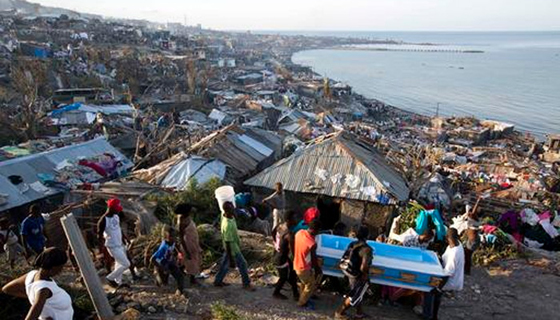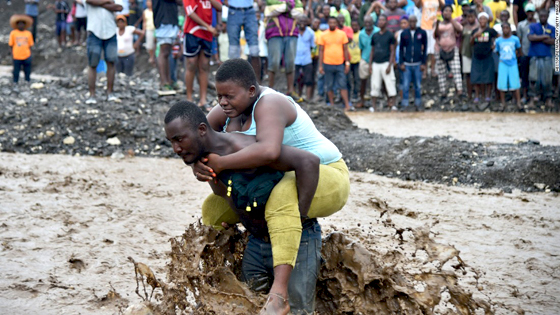Haiti, Oct 8: Hurricane Hurricane Matthew`s trail of destruction in Haiti stunned those emerging from the aftermath on Friday, with the number of dead soaring to 877, tens of thousands left homeless and outbreaks of cholera already claiming more lives.

Information trickled in from remote areas that were cut off by the storm and it became clear that at least 175 people died in villages clustered among the hills and on the coast of Haiti`s fertile western tip.
Matthew triggered mass evacuations along the United States coast from Florida through Georgia and into South Carolina and North Carolina.
U.S. President Barack Obama urged people not to be complacent and to heed safety instructions.
“The potential for storm surge, loss of life and severe property damage exists," Obama told reporters, after a briefing with emergency management officials about the fiercest cyclone to affect the United States since Superstorm Sandy four years ago.
Matthew smashed through Haiti's western peninsula on Tuesday with 145 mile-per-hour (233 km-per-hour) winds and torrential rain. Some 61,500 people were in shelters, officials said, after the storm pushed the sea into fragile coastal villages, some of which were only now being contacted.
While highlighting the misery of underdevelopment in Haiti, which is still recovering from a devastating 2010 earthquake, the storm looked certain to rekindle the debate about global warming and the long-term threat posed to low-lying cities and towns by rising sea levels.
At least three towns in the hills and coast of Haiti`s fertile western tip reported dozens of people killed, including the farming village of Chantal where the mayor said 86 people died, mostly when trees crushed houses. He said 20 others were missing.
"A tree fell on the house and flattened it. The entire house fell on us. I couldn't get out," said driver Jean-Pierre Jean-Donald, 27, who had been married for only a year.
"People came to lift the rubble, and then we saw my wife who had died in the same spot," Jean-Donald said, his young daughter by his side, crying "Mommy."
In the town of Anse-d`Hainault, seven people died of cholera, a disease that did not exist in Haiti until U.N. peace keepers introduced it after a 2010 earthquake that killed some 200,000 people.
Another 17 cholera cases were reported in Chardonnieres on the south coast.
"Due to massive flooding and its impact on water and sanitation infrastructure, cholera cases are expected to surge after Hurricane Matthew and through the normal rainy season until the start of 2017," the Pan American Health Organization (PAHO) said in a statement.
With cellphone networks down and roads flooded, aid has been slow to reach hard-hit areas in Haiti. Food was scarce, and at least seven people died of cholera, likely because of flood water mixing with sewage.
The Mesa Verde, a U.S. Navy amphibious transport dock ship, was heading for Haiti to support relief efforts. The ship has heavy-lift helicopters, bulldozers, fresh water delivery vehicles and two surgical operating rooms.
Matthew sideswiped Florida's coast with winds of up to 120 mph (195 kph) but did not make landfall in the state. The U.S. National Hurricane Center (NHC) downgraded the storm to a Category 2 on the five-step Saffir-Simpson scale of hurricane intensity as its sustained winds dropped to 110 mph. Category 5 is the strongest.
There were at least four storm-related deaths in Florida but no immediate reports of significant damage in cities and towns where the storm swamped streets, toppled trees and knocked out power to more than 1 million people.
Two people were killed by falling trees, according to Florida officials, and an elderly couple died of carbon monoxide poisoning from a generator while sheltering from the storm inside a garage.
Hurricane warnings late on Friday extended up the Atlantic coast from northeast Florida through Georgia and South Carolina and into North Carolina.
In Daytona Beach, the street under the city`s famed "World`s Most Famous Beach" sign was clogged with debris washed up by the ocean. The waves had receded by early afternoon, but there was damage throughout the city, including a facade ripped off the front of a seaside hotel.
Robert Walker, a 51-year-old mechanic, weathered the worst of the storm in his seaside Daytona Beach apartment where high-powered winds peeled back the roof.
"It sounded like a jet plane coming over. I was scared," said Walker, as he stood in front of the battered remains of the two-story building.
At 10 p.m. EDT (0200 GMT Saturday) Matthew's eye or center was about 90 miles (140 km) east-southeast of Savannah, Georgia and moving northward at 12 miles (19 km) per hour, the NHC said.
After passing near or over the coast of Georgia it was on a track that would put it near or over South Carolina on Saturday. Though gradually weakening, it was forecast to remain a hurricane until it begins moving away from the U.S. Southeast on Sunday, the NHC said.
Craig Fugate, director of the Federal Emergency Management Agency, said he was concerned that relatively light damage so far could give people up the coast a false sense of security.
"People should not be looking at the damages they're seeing and saying this storm is not that bad," Fugate told NBC.
"The real danger still is storm surge, particularly in northern Florida and southern Georgia. These are very vulnerable areas. They`ve never seen this kind of damage potential since the late 1800s," Fugate said.
In St. Augustine just south of Jacksonville, Florida, about half of the 14,000 residents refused to heed evacuation orders despite warnings of an 8-foot (2.4-meter) storm surge that could sink entire neighborhoods, Mayor Nancy Shaver said in a telephone interview from the area's emergency operations center.
Television images later showed water surging through streets in the historic downtown area of St. Augustine, the oldest U.S. city and a major tourist attraction.
"There's that whole inability to suspend disbelief that I think really affects people in a time like this," Shaver said.






Comments
Add new comment